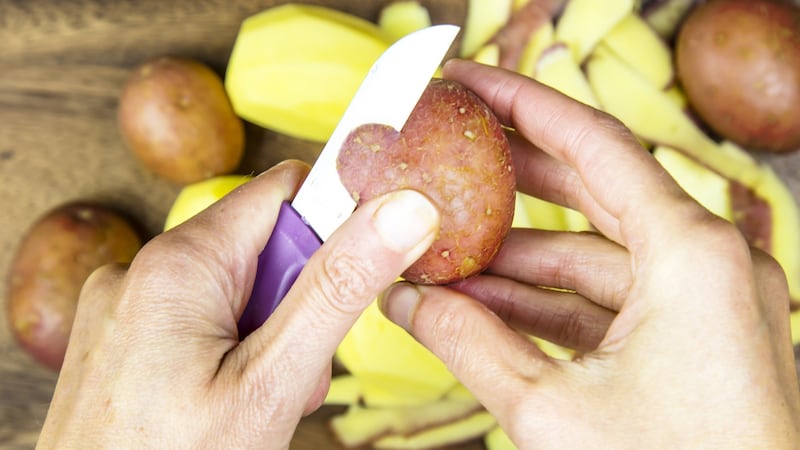The first thing you need to know about me and potatoes is – and you may want to sit down for this – in the United States, we buy them one spud at a time.
They basically come in only two varieties, starchy and waxy. And our per capita consumption (absent chips, which we call French fries, and crisps, which we call chips) is only 13kg a year. I think I’ve seen shoppers at my local Super Valu with more than that in their trolley.
So it was that I was in a state of profound potato ignorance when I arrived in Ireland two years ago. I’d like to say that I have mastered the subject since, but I would be lying.
I did start off strong. My first batch of roasties were the best I’d ever made, crisp and crusty on the outside, fluffy in the centre and with such great flavour. But did I make note of the variety? No I did not.
They earned me some well-deserved opprobrium on social media. Roasting a Queen? I might as well have been adding ice to my Guinness
And my second attempt, made with freshly dug Wexford Queens, not only were not as good, they also earned me some well-deserved opprobrium on social media. Roasting a Queen? I might as well have been adding ice to my Guinness.
It’s been hit or miss ever since.
So with St Patrick’s Day approaching, and the appearance of roadside stands selling local Queens not far behind, I figured it was finally time to get educated.
Maris Piper, Kerr’s Pink, Golden Wonder, Rooster, Queen – what are the differences? Which is best for steaming, for mash, to tuck in beside the chicken for my beloved roasties?
If you would believe the packaging, all of them seem to be equally good for everything. But hard experience has taught me that is not the case.
Expert advice
So I decided to call in the experts. Who knows more about potatoes than the farmers who grow them?
I talked to Maria Flynn, from micro-grower Ballymakenny Potato Farm near Drogheda, Co Louth, and maxi-grower Michael Hoey, president of the Irish Potato Federation and head of Country Crest, a grower-shipper based in Rathmooney, Co. Dublin.
Roosters, the dominant potato in Irish markets, were introduced in 1991... They now account for a whopping 70 per cent of all potatoes sold in Ireland
Flynn and her husband David have built a solid business selling specialty potatoes to fine restaurants. Hoey’s company supplies potatoes to Tesco stores across the island. Despite the differences in business plans, they generally agreed on their potatoes.
Roosters, the dominant potato in Irish markets, were introduced in 1991 by Carlow agronomist Harry Kehoe. Farmers love them because they’re disease-resistant and productive and they now account for a whopping 70 per cent of all potatoes sold in Ireland.
They’re often described as an “all-rounder”, because they are acceptable for most uses. But they’re rarely more than that. “It’s not perfect at anything but it does a good job at most things,” Hoey says, diplomatically.
Seekers of old-time flavour generally prefer Kerr’s Pink and Golden Wonder, says Flynn – the Wonder, in particular. It is the closest descendent of the old Lumper potato that dates to the Famine. “On the whole, it’s a generational thing,” she says. “Most of the customers who ask for them are in their 60s, 70s and 80s.”
Hoey says the preference is also regional. “They’re popular especially in country areas in Ireland, where we have a very critical customer base. They expect certain flavours. They are connoisseurs and expect everything to be right.”
Both are very floury potatoes, the Golden Wonder especially so. “You have to be so careful with that variety,” says Hoey. “If you boil it, it just breaks into bits. The right way to do that is to steam it. But it has such a beautiful flavour to it.”
Maris Pipers are popular potatoes for chips, but can be used for baking as well. Flynn also likes them for roasties, which she points out is just “a chip by another name.”
Road tests
Thus informed, I turned to the kitchen for road tests of the three older varieties now available.
On first impression, I could see why maybe the Golden Wonder had fallen in popularity. It is a small potato and oddly shaped, with a beak-like protuberance at one end. The flesh seemed oddly dense and peeling it was almost like carving wood. The Kerr’s Pink and Maris Piper, on the other hand, are larger, more evenly shaped and easier to peel.

But when it came to taste, the Golden Wonder lived up to its name. Simply steamed it had a light, fluffy texture and a deep, rich flavour that married with a bit of butter quite wonderfully. The Kerr’s Pink and Maris Piper were somewhat firmer and had a little more subtle flavour with a slight bitterness that still was actually quite nice with butter.
The Pink had, for me, the best combination of flavour and texture
Roasted, the Wonder developed the best crust of all, but I found the flavour was somewhat muted, especially compared with when it was steamed.
The Piper had richer flavour and crusted nicely, but the interior was somewhat dense rather than fluffy. The Pink had, for me, the best combination of flavour and texture.
Bear in mind, though, that these are the pronouncements of a potato novice. I now know more than when I started, but this blow-in still sees a long, tuberous journey ahead of me.











